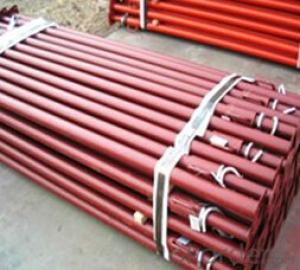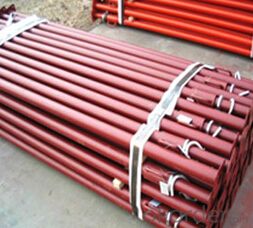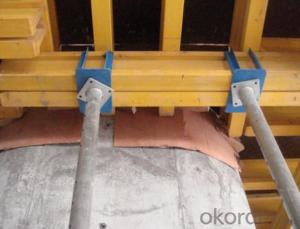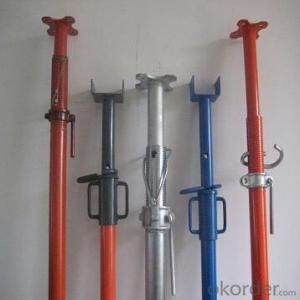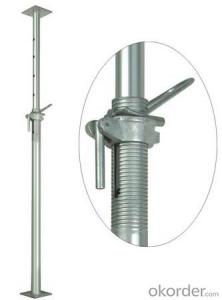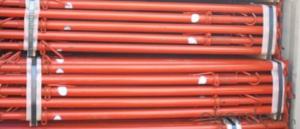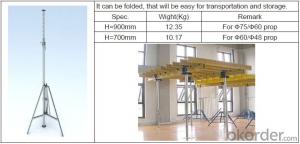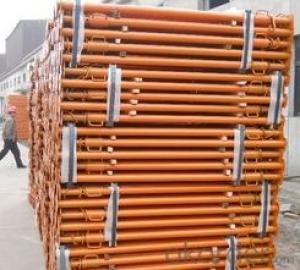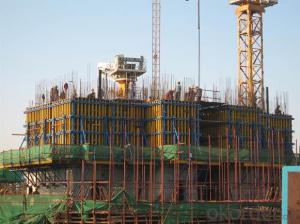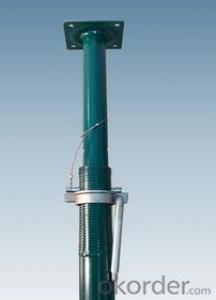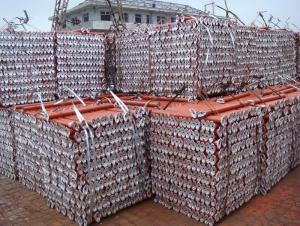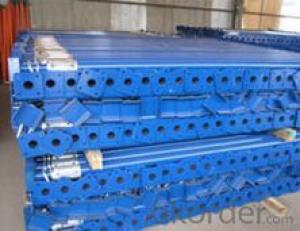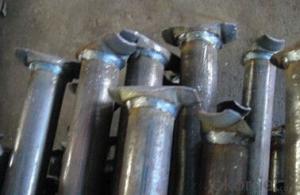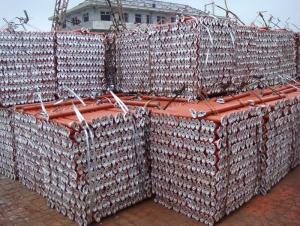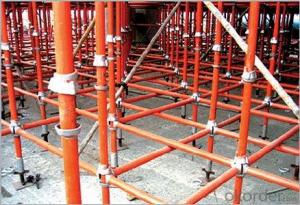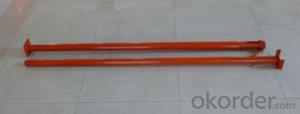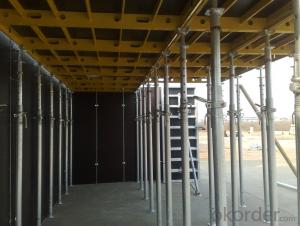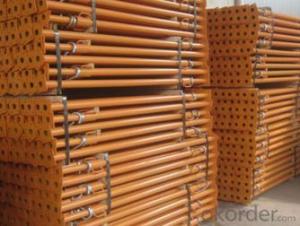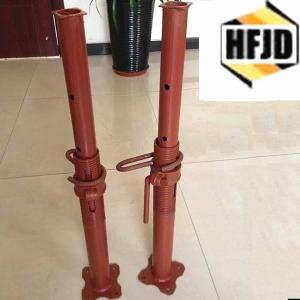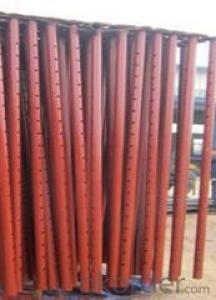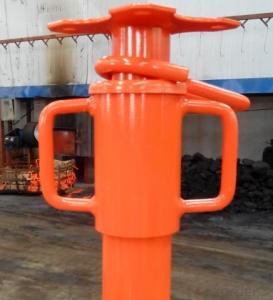cup lock scaffolding standard &cup lock scaffolding ledger OEM SERVICE, MANUFACTURER
- Loading Port:
- Tianjin
- Payment Terms:
- TT OR LC
- Min Order Qty:
- 10000 PCS
- Supply Capability:
- 10000 PCS/month
OKorder Service Pledge
OKorder Financial Service
You Might Also Like
Quick Details
| Size:: | 48.3*3.25mm | ||||
| Material:: | Steel (Q235/Q345) | Surface:: | Electro Galvanized/Self Color/Painted/HDG | Component:: | Standard, Ledger, Diagonal, Bracket, Top&Bottom cup, Ledger blade etc |
Packaging & Delivery
| Packaging Detail: | As the Requirment of Clients |
| Delivery Detail: | 20 days |
Specifications
1.OEM Service,EN74 & BS1139
2.competitive price,fast delivery,good service
3.more than ten-years' experience
4. Samples ok
Product Description
Cuplock Scaffolding System and Accessory for Construction Slab Formwork
It is a multi purpose system scaffold, suitable for access and formwork support in all types of construction of building & civil engineering projects. This complete galvanized system is probably the fastest and most-widely preferred scaffold system.
Material: Steel (Q235/Q345)
Size: 48.3*3.25mm
Surface: Electro Galvanized/Self Color/Painted/HDG
Component:
Standard, Ledger, Strengthened ledger, Transom Beam, Diagonal, Bracket, Top cup, Bottom cup, Ledger blade, etc.
Application:
Highways/Subways, Bridges, Tunnels and Fire Electrical Engineering, Marine Engineering
Advantage: Durable, Stable, Skid-proof, Antirust, Easy to assemble & Dismantle
OEM service is available
Custom-made service is available
- Q: Are steel props suitable for supporting temporary seating arrangements?
- Yes, steel props are suitable for supporting temporary seating arrangements. Steel props, also known as steel shoring props or acrow props, are adjustable telescopic steel tubes that are commonly used in construction and temporary support applications. They are designed to provide reliable and robust support, making them ideal for supporting temporary seating arrangements. Steel props can be easily adjusted to the desired height by extending or retracting the tubes, allowing for flexible seating arrangements. They have a high load-bearing capacity and can withstand heavy loads, ensuring the stability and safety of the seating structure. Additionally, steel props are durable and resistant to wear and tear, making them suitable for long-term use in temporary seating arrangements. Moreover, steel props are versatile and can be used in various configurations to support different types of seating arrangements. They can be combined with other temporary support systems, such as scaffolding or modular staging, to create customized seating structures that meet specific requirements. The adjustable nature of steel props also allows for easy installation and dismantling, making them convenient for temporary seating setups that need to be frequently assembled and disassembled. Overall, steel props offer a reliable and sturdy solution for supporting temporary seating arrangements. Their adjustable height, high load-bearing capacity, durability, and versatility make them a suitable choice for ensuring the stability and safety of temporary seating structures.
- Q: How do you transport steel props safely?
- To safely transport steel props, careful planning and adherence to specific guidelines are necessary. To ensure safe transportation, here are several steps that can be taken: 1. Preparation of the props: It is essential to properly secure and package the steel props before transporting them. Remove any loose or detachable parts and bundle them together to prevent damage during transit. 2. Selection of suitable packaging: Choose sturdy packaging materials capable of supporting the weight and size of the props. Wooden crates or pallets with padding or cushioning should be used to protect the props from scratches, dents, or other forms of damage. 3. Securing the props: Ensure that the props are tightly secured within the packaging. Utilize straps or ropes to hold them in place and prevent movement during transportation. This minimizes the risk of accidents, such as falling or shifting of the props. 4. Usage of appropriate lifting equipment: Employ appropriate lifting equipment, such as a forklift or crane, when loading and unloading the props. This will prevent strain or injuries, ensuring that the props are handled with care and reducing the risk of accidents during transportation. 5. Compliance with transportation regulations: Adhere to local transportation regulations and guidelines when moving steel props. Verify if any permits or special arrangements are necessary for oversized or heavy loads. By complying with these regulations, safety is ensured, and potential legal issues are avoided. 6. Consideration of weather conditions: Take into account the weather conditions during transportation. Extreme temperatures, rain, or snow can impact the props' condition. If needed, cover the props with waterproof materials to shield them from moisture or other weather-related damages. 7. Monitoring of the transportation process: Regularly monitor and inspect the props during transit to ensure they remain secure and undamaged. If any issues are detected, address them promptly to prevent further damage or accidents. By following these steps, steel props can be transported safely, reducing the risk of damage and ensuring they reach their destination in excellent condition.
- Q: Why are steel braces less concrete?
- When no toughness stress will be hard, easily broken, and the concrete is flexible, a buffer force, thank you
- Q: Are steel props resistant to fire?
- Yes, steel props are generally resistant to fire due to their high melting point and ability to maintain structural integrity even under high temperatures. However, it is important to note that extreme heat and prolonged exposure to fire can still affect their strength and stability.
- Q: How do steel props contribute to the prevention of floor and wall cracking?
- Steel props contribute to the prevention of floor and wall cracking by providing additional support and stability to the structure. These props help distribute the weight and load evenly, reducing the chances of excessive stress on the floors and walls. This prevents any potential movement or settlement that could lead to cracks. The steel props also act as temporary supports during construction, ensuring that the structure remains level and stable, thereby preventing any potential cracking.
- Q: How do you determine the correct size of a steel prop for a specific application?
- To determine the correct size of a steel prop for a specific application, several factors need to be considered. The key factors include the load that the prop will be supporting, the height or span it needs to cover, and any additional requirements such as safety regulations or standards. Engineers typically use structural analysis and calculation methods to determine the appropriate size that can safely handle the expected load and provide sufficient stability for the given application.
- Q: How do steel props compare to timber beams in terms of performance?
- Steel props and timber beams have different characteristics and performance capabilities, making them suitable for different applications. Steel props, also known as adjustable steel props or acrow props, are commonly used in construction to support temporary loads, such as formwork and scaffolding. They are made from high-quality steel and can be adjusted to various lengths, providing versatility and adaptability. Steel props have a high load-bearing capacity and are able to withstand substantial weights, making them suitable for heavy-duty applications. Additionally, they offer excellent stability and are resistant to warping or bending, ensuring consistent performance. On the other hand, timber beams are often used in residential construction and other applications where aesthetics and cost-effectiveness are important factors. Timber beams are lightweight and easy to handle, making them ideal for smaller-scale projects. They also have good insulation properties, making them suitable for applications where thermal efficiency is essential. However, timber beams have lower load-bearing capacities compared to steel props and are more susceptible to warping, rotting, and termite damage. In terms of performance, steel props are generally considered to be more reliable and durable than timber beams. They are capable of supporting heavier loads, providing greater stability and safety in construction projects. Steel props are also reusable and require less maintenance compared to timber beams, making them a cost-effective option in the long run. However, timber beams may still be preferred in certain situations where aesthetics and cost are prioritized over load-bearing capacity, such as in residential construction or interior design projects. Ultimately, the choice between steel props and timber beams depends on the specific requirements of the project, including load-bearing capacity, durability, cost, and aesthetic considerations. It is important to consult with professionals and consider the specific needs of the project before making a decision.
- Q: How do you ensure the stability of a steel prop in high winds?
- To ensure the stability of a steel prop in high winds, there are several measures that can be taken: 1. Proper anchoring: The steel prop should be securely anchored to the ground using suitable methods such as ground stakes, concrete footings, or heavy-duty screws. This will provide a solid foundation and prevent the prop from being blown over by strong winds. 2. Increased weight: Adding additional weights to the steel prop can help increase its stability. This can be achieved by attaching sandbags or other heavy objects to the base or structure of the prop. The added weight will make it more resistant to wind forces. 3. Reinforcement: Strengthening the steel prop by reinforcing its structure can significantly enhance its stability. This can involve adding cross bracing or diagonal supports to the prop, which will help distribute the wind load evenly and prevent it from swaying or toppling. 4. Wind-resistant design: When designing or selecting a steel prop, considering its wind resistance characteristics is crucial. Look for props that have a streamlined shape or include features such as wind deflectors, which can help minimize the impact of wind pressure. 5. Regular inspections and maintenance: Regularly inspecting the steel prop for any signs of damage or wear is essential. Any loose bolts, cracks, or other structural issues should be addressed promptly. Additionally, maintaining the prop by ensuring it is properly lubricated and free from rust or corrosion will ensure its long-term stability. It is important to note that the specific measures required to ensure the stability of a steel prop in high winds may vary depending on the specific circumstances and the wind intensity in the area. Consulting with a structural engineer or following the manufacturer's guidelines can provide further guidance on ensuring the stability of the steel prop in high winds.
- Q: How do you maintain and clean steel props?
- To maintain and clean steel props, there are a few key steps that can be followed. Firstly, it is important to regularly inspect the steel props for any signs of damage or wear. This can be done by visually examining the props and checking for any cracks, dents, or rust. If any issues are found, they should be addressed immediately to prevent further damage and ensure the safety of the props. To clean steel props, a thorough cleaning process can be followed. Start by removing any loose dirt or debris from the props using a brush or compressed air. Next, prepare a solution of warm water and mild detergent. Dip a clean cloth or sponge into the solution and gently scrub the props, paying extra attention to any areas with stubborn stains or dirt. Rinse the props thoroughly with clean water to remove any soap residue. After cleaning, it is important to dry the steel props completely to prevent the formation of rust. Use a clean towel or allow the props to air dry in a well-ventilated area. Once dry, it is recommended to apply a thin layer of lubricant or rust inhibitor to the props to provide additional protection against corrosion. In addition to regular cleaning, it is important to store steel props properly to maintain their condition. Store them in a dry and well-ventilated area, away from moisture and extreme temperatures. If the props are not in use for an extended period, it is advisable to apply a thicker layer of rust inhibitor and wrap them in a protective covering. By following these maintenance and cleaning practices, steel props can be kept in optimal condition, ensuring their longevity and safety during use.
- Q: What are the safety precautions to consider when using steel props?
- To ensure the wellbeing of workers and prevent accidents, it is imperative to consider several safety precautions when using steel props. Some crucial safety measures include the following: 1. Thorough inspection is essential before using steel props. Carefully examine each prop for any signs of damage such as cracks, bends, or dents. If any defects are detected, replace the prop immediately. 2. Proper handling of steel props requires using appropriate lifting techniques. Make sure the props are lifted and carried by teams of workers, distributing the weight evenly. Avoid sudden or jerky movements that could cause the props to fall or injure someone. 3. Correct positioning of steel props is crucial for providing adequate support. Avoid placing them on unstable or uneven ground, as this can lead to accidents or collapse. Additionally, ensure that the props are correctly aligned and positioned to support the intended load. 4. Each steel prop has a specific load capacity that must not be exceeded. It is crucial to ensure that the weight placed on the props does not surpass their maximum load limit. Overloading can result in prop buckling or collapse, leading to serious accidents. 5. To maintain stability, steel props should be properly braced and secured. This can be achieved by using diagonal bracing or other forms of support to prevent lateral movement. Additionally, secure the props at both the top and bottom to prevent displacement or tipping. 6. Regular inspection of steel props is necessary throughout the project's duration to ensure ongoing safety. This includes checking for any signs of deterioration or damage and taking appropriate action if any issues are identified. 7. Adequate training and clear communication are vital when using steel props. Workers should receive proper training on how to handle and use the props safely. Additionally, establish clear communication among the team to ensure everyone understands their roles and responsibilities when working with steel props. By following these safety precautions, the risk of accidents and injuries when using steel props can be significantly reduced. It is important to prioritize safety at all times and promptly address any concerns to maintain a safe working environment.
Send your message to us
cup lock scaffolding standard &cup lock scaffolding ledger OEM SERVICE, MANUFACTURER
- Loading Port:
- Tianjin
- Payment Terms:
- TT OR LC
- Min Order Qty:
- 10000 PCS
- Supply Capability:
- 10000 PCS/month
OKorder Service Pledge
OKorder Financial Service
Similar products
Hot products
Hot Searches
